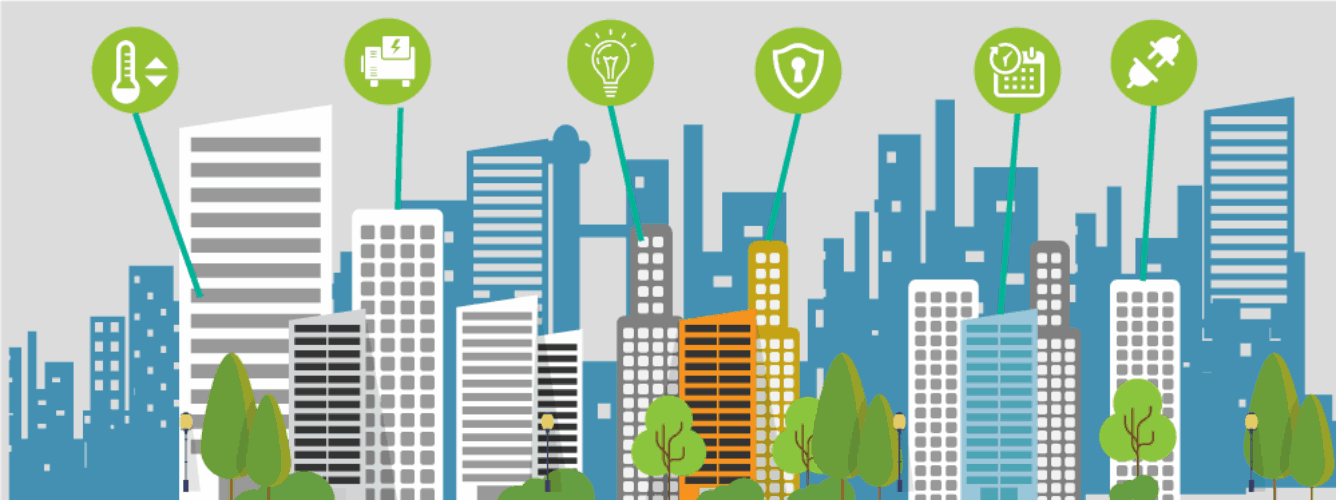Building management trends 2025-2026 – Building automation at the forefront.
Building management relies on complex technological strategies. It’s easy to lose sight of priorities and for things to become blurred. In this article, we’ll shed some light on a key strategy in building services: building automation.
Find out what building automation is, its main functions, hosting solutions and current trends.
What is building automation?
Building automation basically refers to all automated systems for managing and optimizing HVAC equipment in a commercial, industrial or public (e.g. hospital) building, sometimes including lighting and security systems.
With reference to our building automation page, the aim of energy management and a building automation system is to optimize occupant comfort while reducing energy consumption. These types of systems provide intelligent, efficient control of the following equipment, among others:
– Thermostats
– Fans, dampers and coils
– Pumps, valves, chillers and boilers
– Fan coils, VAV systems and rooftop units
– Heat exchangers
Building automation plays a crucial role in monitoring and optimizing temperature, pressure, humidity and flow rates, ensuring modern, high-performance building management.
For a more detailed description, refer to our article: Discover the world of building automation
What are the benefits of building automation?
Here are just a few of the main functions that make building automation an advantageous option for your building:
– Energy management: Optimize energy consumption to reduce costs and carbon footprint.
– Security: Monitoring and access control, fire detection and alarm systems.
– Comfort: Temperature, lighting and ventilation control to enhance occupant well-being.
– Communication: Integration of telecommunications systems and computer networks for efficient, centralized management.
In this way, building automation enables the creation of intelligent buildings, capable of adapting to user needs while improving operational efficiency.
How does hosting a building automation system work?
All these systems need to be connected within a technological environment. At BAULNE, we favor the implementation of a centralized, connected system via cloud computing. In this way, customers can manage multiple sites without worrying about IT security risks. On the other hand, for customers who prefer customized management, the implementation can be completed on a local industrial server.
Building management trends 2025-2026
Building automation trends in the industry are evolving rapidly with the integration of new technologies and a growing emphasis on energy efficiency and sustainability. Here are some of the current trends influencing building automation processes:
- Machine Learning ML: The use of “machine learning” makes it possible to analyze building data to optimize energy management, safety and comfort systems. Algorithms learn and adjust in real time, offering more precise and efficient solutions.
- Internet of Things (IoT): The integration of sensors and connected devices enables real-time management of infrastructures. These devices are often connected to cloud platforms, facilitating data collection and analysis for smarter, more responsive management.
- Predictive maintenance: Thanks to data analysis, predictive maintenance enables equipment failures to be predicted and prevented before they occur. This approach reduces downtime and repair costs by anticipating maintenance needs.
- Enhanced security: Surveillance and access control systems benefit from advanced technologies such as smart cameras and biometric access control. These innovations enhance building security by offering more robust and responsive solutions.
- Renewable energy and electrical grid integration: The integration of renewable energy sources, such as solar panels, and the intelligent management of electrical grids are becoming key elements in improving the sustainability and energy efficiency of buildings.
- Intelligent user interfaces: User interfaces, such as mobile apps and interactive control panels, are becoming increasingly sophisticated, enabling occupants to easily control and optimize their environment.
These trends point to a move towards more intelligent, efficient and sustainable building management systems. Continued innovation in this field promises significant improvements in energy efficiency and occupant comfort.
Interested in building automation? Want to understand more? Our experts can help.




